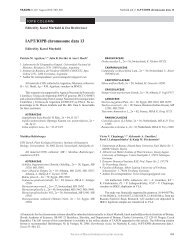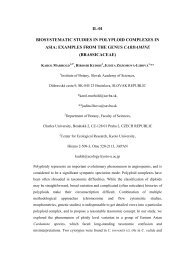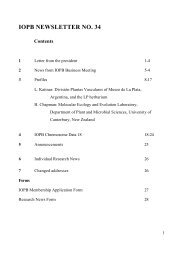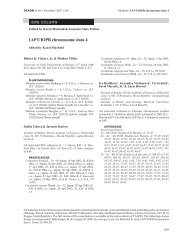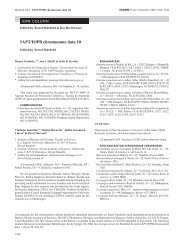CONTENS - International Organization of Plant Biosystematists
CONTENS - International Organization of Plant Biosystematists
CONTENS - International Organization of Plant Biosystematists
Create successful ePaper yourself
Turn your PDF publications into a flip-book with our unique Google optimized e-Paper software.
O 27<br />
Participation <strong>of</strong> the high mountainous grass Colpodium versicolor<br />
(Poaceae) in the evolution <strong>of</strong> some Zingeria species<br />
Violetta Kotseruba 1 , Klaus Pistrick 2 , Anahit Ghukasyan 3 , Andreas Houben 2<br />
1<br />
Komarov Botanical Inst., 197376 St. Petersburg, Russia,<br />
viola.kotseruba@gmail.com<br />
2<br />
Leibniz-Institute <strong>of</strong> <strong>Plant</strong> Genetics and Crop <strong>Plant</strong> Research (IPK), 06466<br />
Gatersleben, Germany, pistrick@ipk-gatersleben.de, houben@ipk-gatersleben.de<br />
3 National Botanical Institute <strong>of</strong> Armenia, Erevan, Armeni, abotanyinst@sci.am<br />
The high mountainous grass Colpodium versicolor (Stev.) Schmalh. has an unusual<br />
low basic chromosome number <strong>of</strong> two considering that the basic number <strong>of</strong><br />
chromosomes <strong>of</strong> the Poaceae family is seven. At this moment we know only four<br />
plants with high reduced chromosome number 2n=4 and two <strong>of</strong> them belong to the<br />
Poaceae family: Colpodium versicolor and Zingeria biebersteiniana (Claus) P.A.<br />
Smirn.<br />
Analyses <strong>of</strong> the relation between these unique two genera <strong>of</strong> grasses including<br />
Colpodium versicolor (2n=2x=4, 2C=2.4 pg) Zingeria biebersteiniana (2n=2x=4,<br />
2C=3.5 pg) Z. trichopoda (Boiss.) P. A. Smirn. (2n=4x=8, 2C=5.3 pg) and Zingeria<br />
kochii (Mez) Tzvelev (2n=6x=12, 2C=6.7pg) revealed a dynamic evolution <strong>of</strong> the<br />
genomes with the following results: (1) Z. trichopoda is <strong>of</strong> amphidiploid origin. Only<br />
four <strong>of</strong> the eight chromosomes <strong>of</strong> Z. trichopoda are strongly labelled after genomic in<br />
situ hybridisation with genomic DNA <strong>of</strong> Z. biebersteiniana. Therefore, Z. trichopoda<br />
evolved from a hybrid involving a species very close to the recent form <strong>of</strong> Z.<br />
biebersteiniana and a second species with a similar low number <strong>of</strong> chromosomes. (2)<br />
Z. kochii is <strong>of</strong> allohexaploid origin. Four <strong>of</strong> the twelve chromosomes <strong>of</strong> Z. kochii are<br />
strongly labelled after genomic in situ hybridisation with genomic DNA <strong>of</strong> Z.<br />
biebersteiniana, and four other chromosomes are strongly labelled with genomic<br />
DNA <strong>of</strong> C. versicolor. Therefore, Z. kochii evolved from a hybrid involving a species<br />
very close to the recent form <strong>of</strong> Z. biebersteiniana and C. versicolor.(3) The 45S<br />
rDNA loci <strong>of</strong> the Z. biebersteiniana-similar component <strong>of</strong> Z. kochii vanished after<br />
amphiploidisation. Supported by: RFBR 06-04-48399, DAAD 325, DFG 2001, DFG<br />
2005.<br />
28



